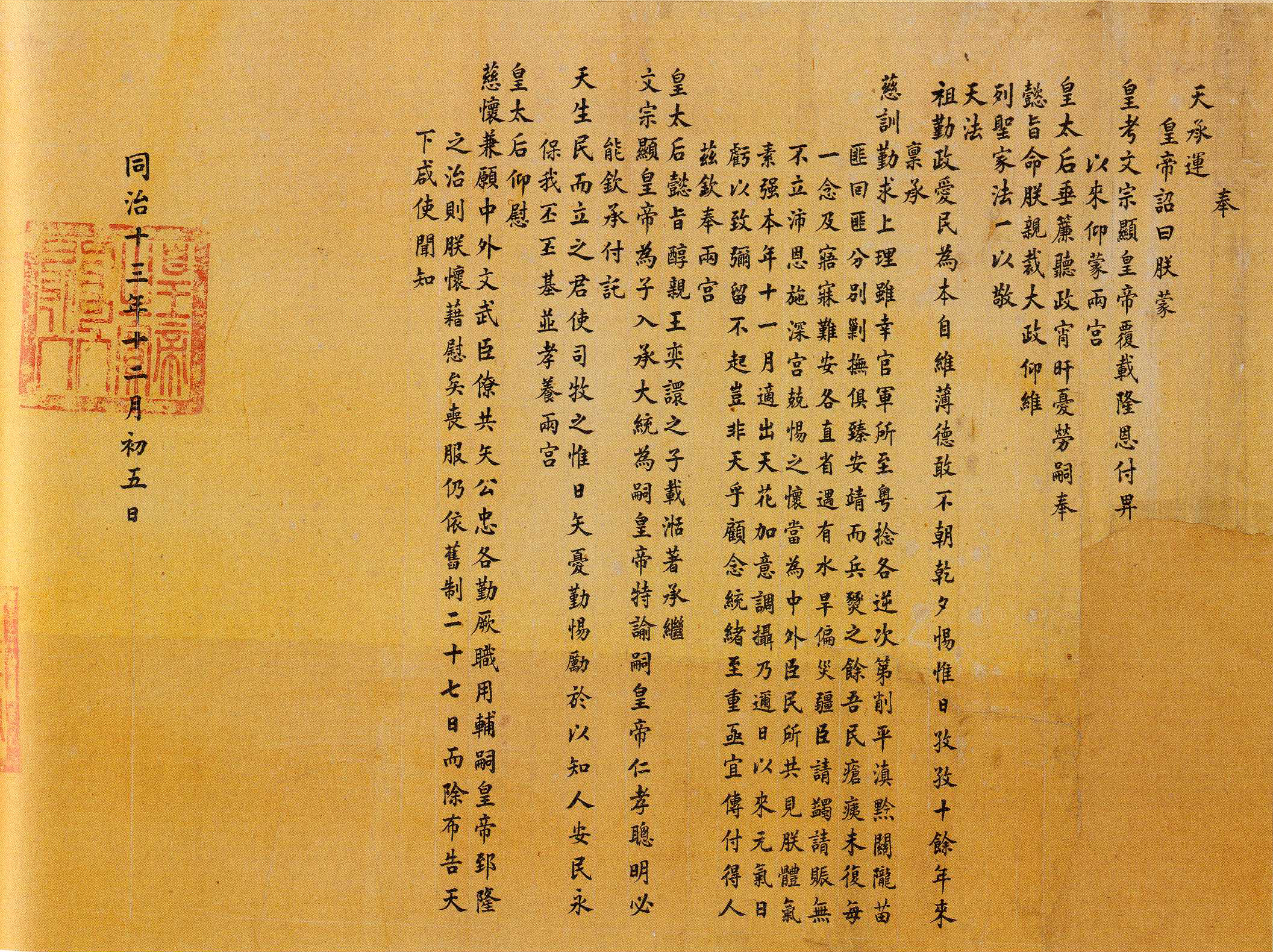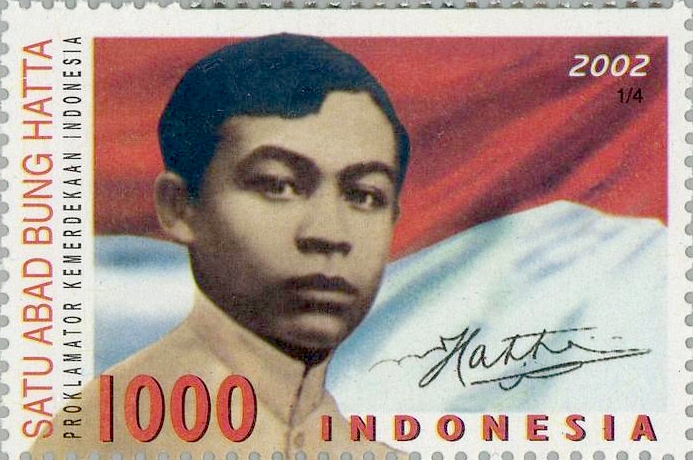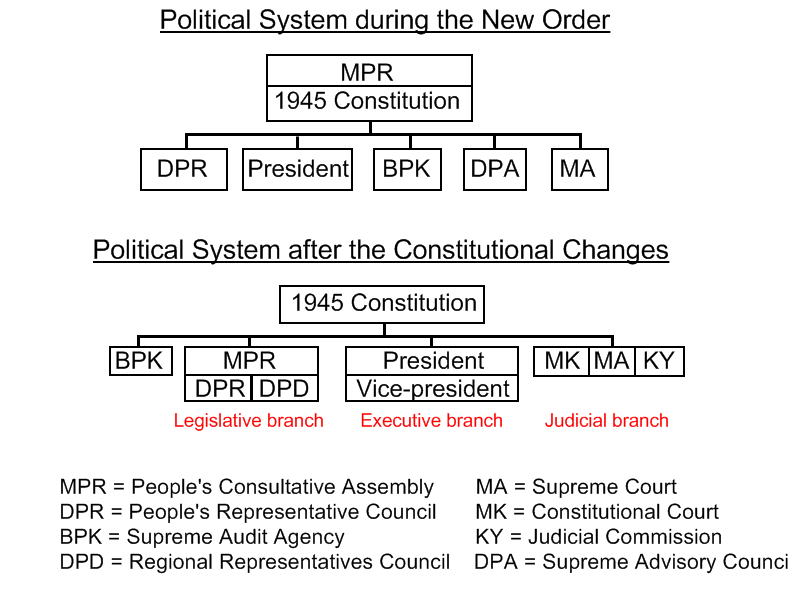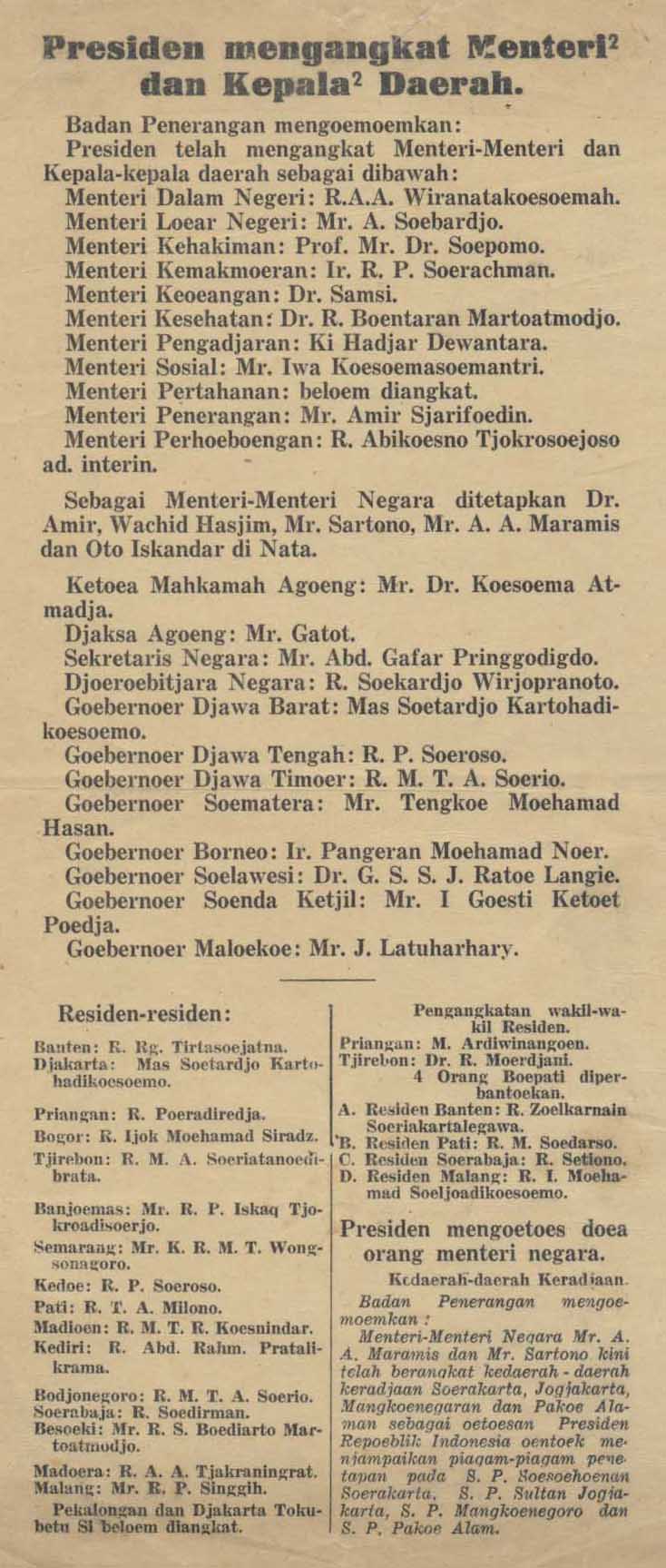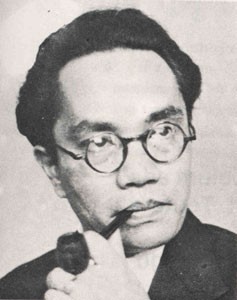|
Vice-Presidential Edict No.X
Vice Presidential Edict No. X () was an edict issued by Indonesian Vice-president Mohammad Hatta on 16 October 1945 which gave the Central Indonesian National Committee (KNIP), initially a purely advisory body, the authority to become the legislative body of the government. Background Following the 17 August 1945 Indonesian Declaration of Independence, on 29 August, the Central Indonesian National Committee (, KNIP) was established to replace the Preparatory Committee for Indonesian Independence (PPKI) in line with the transitional provisions of the provisional Constitution of Indonesia. Under these provisions, the KNIP was an advisory body pending the election of the legislature, the People's Representative Council (DPR). However the KNIP had no legislative authority as all power was vested in the hands of the president. It comprised 135 members appointed by President Sukarno aided by Vice-president Hatta, including the entire membership of the PPKI. Resentment over the composit ... [...More Info...] [...Related Items...] OR: [Wikipedia] [Google] [Baidu] |
Edict
An edict is a decree or announcement of a law, often associated with monarchies, but it can be under any official authority. Synonyms include "dictum" and "pronouncement". ''Edict'' derives from the Latin edictum. Notable edicts * Telepinu Proclamation, by Telipinu, king of the Hittites. Written c. 1550 BC, it helped archeologists to construct a succession of Hittite Kings. It also recounts Mursili I's conquest of Babylon. * Edicts of Ashoka, by the Mauryan emperor, Ashoka, during his reign from 272 BC to 231 BC. * Reform of Roman Calendar, Julian Calendar, took effect on 1 January AUC 709 (45 BC). * Edictum perpetuum (129), an Imperial revision of the long-standing Praetor's Edict, a periodic document which first began under the late Roman Republic (c. 509–44 BC). * Edict on Maximum Prices (301), by Roman Emperor Diocletian. It attempted to reform the Roman system of taxation and to stabilize the coinage. * Edict of Toleration (311), by Galerius before hi ... [...More Info...] [...Related Items...] OR: [Wikipedia] [Google] [Baidu] |
Mohammad Hatta
Mohammad Hatta ( ; 12 August 1902 – 14 March 1980) was an Indonesian statesman, nationalist, and independence activist who served as the country's first Vice President of Indonesia, vice president as well as the third prime minister. Known as "The Proclamator", he and a number of Indonesians, including the first president of Indonesia, Sukarno, fought for the independence of Indonesia from the Netherlands. Hatta was an important figure during the Indonesian national awakening and during the national revolution. As a youth he was politically active in both the Netherlands and the Indies, which led him to be imprisoned in the Boven-Digoel concentration camp, Boven Digoel concentration camp for his activism. He also played a crucial role in the proclamation of Indonesian independence, being the second person to sign the declaration besides Sukarno, thus making him one of the founders of Indonesia. Early life, family, and early education Early life and family Hatta was born in ... [...More Info...] [...Related Items...] OR: [Wikipedia] [Google] [Baidu] |
Central Indonesian National Committee
The Central Indonesian National Committee (, KNIP), also known as the Central National Committee (, KNP), was a body appointed to assist the president of the newly independent Indonesia. Originally purely advisory, it later gained assumed legislative functions. The Working Committee of the KNIP became part of the People's Representative Council when Indonesia became a unitary state in 1950. Pre-independence bodies The Japanese Dutch East Indies campaign, invaded Indonesia in 1942. By 1943 the tide had turned against them, and in order to encourage support for the war effort, the Japanese appointed Indonesian advisors () to the administration and appointed nationalist leader Sukarno leader of a new Central Advisory Council, Central Advisory Board () in Jakarta. In March 1945, the Japanese established the Investigating Committee for Preparatory Work for Independence () or BPUPK, chaired by Radjiman Wediodiningrat, with Sukarno, Mohammad Hatta, Hatta and Thamrin among its members. ... [...More Info...] [...Related Items...] OR: [Wikipedia] [Google] [Baidu] |
Indonesian Declaration Of Independence
The Proclamation of Indonesian Independence (, or simply ''Proklamasi'') was read at 10:00 Tokyo Standard Time on Friday 17 August 1945 in Jakarta. The declaration marked the start of the diplomatic and armed resistance of the Indonesian National Revolution, fighting against the forces of the Netherlands and pro-Dutch civilians, until the latter officially acknowledged Indonesia's independence in 1949. The document was signed by Sukarno and Mohammad Hatta, who were appointed president and vice-president respectively the following day. The date of the Proclamation of Indonesian Independence was made a public holiday by a government decree issued on 18 June 1946. Background The beginnings of the independence movement In 1918, the Dutch authorities in the Dutch East Indies established a partly-elected People's Council, the '' Volksraad'', which for the first time gave Indonesian nationalists a voice. Meanwhile, Indonesian students studying in the Netherlands formed the Perhimpo ... [...More Info...] [...Related Items...] OR: [Wikipedia] [Google] [Baidu] |
Preparatory Committee For Indonesian Independence
The Preparatory Committee for Indonesian Independence (, abbreviated as PPKI; , Hepburn romanization, Hepburn: ) was a body established on 7 August 1945 to prepare for the transfer of authority from the Japanese occupation of the Dutch East Indies, occupying Japanese to Indonesia. It approved and promulgated the first Constitution of Indonesia, and appointed Sukarno and Mohammad Hatta as the first President of Indonesia, president and vice president of Indonesia, respectively. Background In two sessions from May to July 1945, the Investigating Committee for Preparatory Work for Independence (BPUPK) decided on Pancasila (politics), Pancasila as the ideological basis of independent Indonesia, and produced a draft constitution. With the war turning against them, the Japanese, who were Japanese occupation of the Dutch East Indies, occupying Indonesia, decided to grant independence in order to create problems for the returning Dutch colonial authorities. The plan was that Java would be ... [...More Info...] [...Related Items...] OR: [Wikipedia] [Google] [Baidu] |
Constitution Of Indonesia
The 1945 Constitution of the Unitary State of the Republic of Indonesia (, commonly abbreviated as ''UUD 1945'' or ''UUD '45'') is the supreme law and basis for all laws of Indonesia. The constitution was written in June–August 1945, in the final months of the Japanese occupation of the Dutch East Indies at the end of World War II. It was abrogated by the Federal Constitution of 1949 and the Provisional Constitution of 1950, but restored by President Sukarno's 1959 Decree. The 1945 Constitution sets forth the Pancasila, the five nationalist principles, as the embodiment of basic principles of an independent Indonesian state. It provides for a limited separation of executive, legislative, and judicial powers. The governmental system has been described as "presidential with parliamentary characteristics."King (2007) Following major upheavals in 1998 and the resignation of President Suharto, several political reforms were set in motion, via amendments to the Constitution, ... [...More Info...] [...Related Items...] OR: [Wikipedia] [Google] [Baidu] |
People's Representative Council
The House of Representatives of the Republic of Indonesia (, DPR-RI or simply DPR) is one of two elected chambers of the People's Consultative Assembly (MPR), the national legislature of Indonesia. It is considered the lower house, while the Regional Representative Council (DPD) serves as the upper house; while the Indonesian constitution does not explicitly mention the divide, the DPR enjoys more power, privilege, and prestige compared to the DPD. Members of the DPR are elected through a general election every five years. Currently, there are 580 members; an increase compared to 575 prior to the 2024 elections. Its members are called Members of Parliament (''anggota dewan''). History ''Volksraad'' In 1915, members of the Indonesian nationalist organisation Budi Utomo and others toured the Netherlands to argue for the establishment of a legislature for the Dutch East Indies, and in December 1916 a bill was passed to establish a '' Volksraad'' (People's Council).Rick ... [...More Info...] [...Related Items...] OR: [Wikipedia] [Google] [Baidu] |
Sukarno
Sukarno (6 June 1901 – 21 June 1970) was an Indonesian statesman, orator, revolutionary, and nationalist who was the first president of Indonesia, serving from 1945 to 1967. Sukarno was the leader of the Indonesian struggle for independence from the Dutch East Indies, Dutch colonialists. He was a prominent leader of Indonesian National Party, Indonesia's nationalist movement during the colonial period and spent over a decade under Dutch detention until released by the Dutch East Indies campaign, invading Empire of Japan, Japanese forces in World War II. Sukarno and his fellow nationalists Collaboration with Imperial Japan#Dutch East Indies (Indonesia), collaborated to garner support for the Japanese war effort from the population, in exchange for Japanese aid in spreading nationalist ideas. Upon Surrender of Japan, Japanese surrender, Sukarno and Mohammad Hatta Proclamation of Indonesian Independence, declared Indonesian independence on 17 August 1945, and Sukarno was appoin ... [...More Info...] [...Related Items...] OR: [Wikipedia] [Google] [Baidu] |
Presidential Cabinet (Indonesia)
The Presidential Cabinet () was the first cabinet established by Indonesia following the 17 August 1945 Indonesian Declaration of Independence. It comprised 20 ministers and four officials. Its term of office ran from 2 September to 14 November 1945. Background Indonesian had been under Japanese occupation since 1942, but by 1943, realizing they were losing the war, the Japanese appointed Indonesian advisors () to the administration and appointed nationalist leader Sukarno leader of a new Central Advisory Board (''Chuo Sani-kai'' ) in Jakarta.Ricklefs (1982) p193 On 7 August, the day after the atomic bombing of Hiroshima, the Preparatory Committee for Indonesian Independence () or PPKI was established. Sukarno was chairman, and Hatta vice-chairman. On 19 August 1945, this body created 12 ministries for Indonesia's first cabinet. The cabinet as formed contained ''sanyo'' as well as officials who had not worked with the Japanese. The cabinet was responsible to President Sukarno. ... [...More Info...] [...Related Items...] OR: [Wikipedia] [Google] [Baidu] |
Japanese Occupation Of The Dutch East Indies
The Empire of Japan occupied the Dutch East Indies (now Indonesia) during World War II from March 1942 until after the end of the war in September 1945. In May 1940, Germany German invasion of the Netherlands, occupied the Netherlands, and martial law was declared in the Dutch East Indies. Following the failure of negotiations between the Dutch authorities and the Japanese, Japanese assets in the archipelago were frozen. The Dutch declared war on Japan following the 7 December 1941 attack on Pearl Harbor. The Japanese invasion of the Dutch East Indies began on 10 January 1942, and the Imperial Japanese Army overran the entire colony in less than three months. The Dutch surrendered on 8 March. Initially, most Indonesians welcomed the Japanese as liberators from their Dutch colonial masters. The sentiment changed, however, as between 4 and 10 million Indonesians were recruited as forced labourers (''romusha'') on economic development and defense projects in Java. Between 200 ... [...More Info...] [...Related Items...] OR: [Wikipedia] [Google] [Baidu] |
Sutan Sjahrir
Sutan Sjahrir (5 March 1909 – 9 April 1966) was an Indonesian statesman and independence leader who served as the first Prime Minister of Indonesia, prime minister of Indonesia from 1945 until 1947. He played a key role during the Indonesian National Revolution and was active in the Indonesian nationalism, nationalist movement during the 1930s. Sjahrir is remembered as an idealist and intellectual. Born to a Minangkabau family, he studied at the University of Amsterdam and later became a law student at Leiden University. He became involved in Socialist politics, and Indonesia's struggle for independence, becoming a close associate of the older independence activist Mohammad Hatta, who would later become the first Vice President of Indonesia. During the Japanese occupation of the Dutch East Indies, Japanese occupation of the Dutch East Indies, Sjahrir fought in the resistance. Towards independence on 17 August 1945, he was involved in the Rengasdengklok Incident and the Proclamat ... [...More Info...] [...Related Items...] OR: [Wikipedia] [Google] [Baidu] |
Amir Sjarifuddin
Amir Sjarifuddin Harahap ( EVO: Amir Sjarifoeddin Harahap; 27 April 1907 – 19 December 1948) was an Indonesian politician and journalist who served as the second prime minister of Indonesia from 1947 until 1948. A major leader of the left wing during the Indonesian National Revolution, he previously served as Minister of Information from 1945 until 1946 and Minister of Defense from 1945 until 1948. Amir was born into the Sumatran aristocracy and was educated at Leiden University. At Leiden, he became a member of the board of the Gymnasium student association in Haarlem and was involved in the Batak student organization '' Jong Batak''. He returned to Indonesia due to family troubles but continued his education at the '' Rechts Hogeschool'' in Batavia. After graduating, he became active in literary and journalist circles, joining the editorial board of the newspaper ''Panorama''. He also became involved with left-wing politics and led a group of younger Marxists in the ... [...More Info...] [...Related Items...] OR: [Wikipedia] [Google] [Baidu] |
